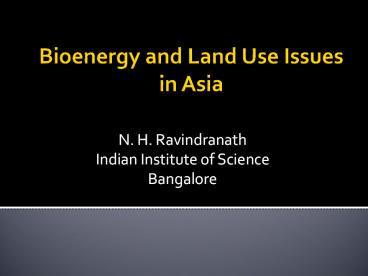Bioenergy and Land Use Issues in Asia - PowerPoint PPT Presentation
Title:
Bioenergy and Land Use Issues in Asia
Description:
Bioenergy and Land Use Issues in Asia N. H. Ravindranath Indian Institute of Science Bangalore Key Messages Multiple options for land use in the context of ... – PowerPoint PPT presentation
Number of Views:88
Avg rating:3.0/5.0
Title: Bioenergy and Land Use Issues in Asia
1
Bioenergy and Land Use Issues in Asia
- N. H. Ravindranath
- Indian Institute of Science
- Bangalore
2
Key Messages
- Multiple options for land use in the context of
mitigating climate change development - Biomass power, biofuels (liquid fuel),
Afforestation for C-sink, timber production for
substituting aluminum, steel, etc - Currently Asia is not a dominant biofuel producer
/ consumer of biofuels (like Brazil, US, EU) - However, dominant energy consumers have set
targets for biofuels to substitute petroleum -
thus Asia will be the key regions for biofules - China (15 - 2020), India (10- 2020), Japan (30
by 2030), Malaysia/Indonesia/Thailand (10 -2020) - 4. Biofuel program in India, China, Thailand etc
are driven by need for Energy Security - Thus need to ensure minimal GHG emissions
3
Key messages
- Area under food production has stabilized in all
the key Asian countries- unlikely to increase - India, China, Thailand, Malaysia, etc
- Food grain needs will be met by increasing crop
productivity and intensity - Large extents of degraded non-crop and marginal
crop lands are available for - bioenergy/ biofuel crops / Carbon sink
- Biodiesel crops such as Jatropha, oil Palm and
tree based crops are key biofuel crops are
critical in Asian countries - India, China, Malaysia, Indonesia
4
Key messages
- Land use for biofuel crops varies with countries
- Degraded and marginal lands for Jatropha India,
China - Forest lands converted for oil Palm Malaysia,
Indonesia - GHG implications vary with land conversions
involved and countries - India China degraded lands and with minimal
energy input - Indonesia Malaysia - forest lands with high
carbon stocks - India China have large biomass power programs
for meeting decentralized power needs - Largely using degraded lands for producing woody
biomass with minimal energy input for production
of feedstock - Likely to provided large GHG benefits by
substituting fossil fuel power generate power
for local applications - India has a large number of CDM projects on
biomass power
5
Land use options for climate mitigation
Biomass power Large potential (e.g., 30 GW in India) Woody biomass based Dedicated energy plantations in degraded lands crop / forest residue Large program for decentralized biopower No serious implications for food security or GHG, since vast degraded land available in most countries
Carbon Seq through Afforestation Reforestation in Degraded lands large potential large afforestation programs - India1.5Mha, China4-5 Mha No serious implications for food security since vast degraded land available in most countries Large carbon sink creation non-wood products
6
Land use options for climate mitigation
Bio-Ethanol Sugarcane program being initiated sugar is the main product biofuel byproduct
Bio-Ethanol Sweet Sorghum, Maize, Cassava, etc. - Marginal scale program
Biodiesel Palm oil Large program in South east Asian countries Jatropha Large program in India, China, etc Tree species yielding oil seeds such as Pongamia, Shorea, Madhuka, etc in India No edible oil-based Biodiesel program
7
Malaysian Palm Oil Production
8
Malaysia
- Palm oil plantations
- lt1 Mha in the 1970s
- 4 million hectares in 2005.
- Producing 15 Mt of crude palm oil
- Target to expand to 5 Mha by 2010
- to produce 20 Mt
9
Case Study of Jatropha in China
- Ethanol
- 2008 1.5 Mha
- 2012 2.4 Mha
- Jatropha Southwest China is the official
targeted area for Jatropha - Estimated area Current and projected in
southwest China barren lands
Estimated current area (ha) Planned area (ha)
Guizhou 1,300 26,667
Sichuan 20,000 333,333
Yunnan 50,000 666,667
Total southwest China 71,300 1.03 million
Source World Agroforestry Centre, 2007
10
Indonesia scale of biofuel program
- Biodiesel
- 2005-07 212,000 ha
- 2008 663,000 ha
- 2017 2.67 Mha
- Bio-ethanol
- 2008 50,000 ha
- 2017 54,000 ha
11
India scale of biofuel program
- Biodiesel
- 2008 279,000 ha
- 2017 340,000 ha
- Bioethanol
- 2008 451,000 ha
- 2017 854,000 ha
12
Trends in Land use Pattern-India
Source http//www.faostat.fao.org/site/377/defaul
t.aspx.
13
Land use pattern projections
14
Afforestation Rate in India
Forest Survey of India., State of Forest Report
Forest Survey of India., State of Forest Report
Source Forest Survey of India., State of Forest
Report
15
Trends in Area under Forests
http//envfor.nic.in/nfap/
16
Land available for biomass production for energy
(Mha)40-65 Mha is available for energy
17
Overall Area Required for Biodiesel Ethanol for
2012
Target Biodiesel Biodiesel Biodiesel Ethanol Ethanol Ethanol
Demand Mt Jatropha Mha Palm Mha Demand Mt Maize S-cane
5 3.5 3.5 1.0 2 1.2 0.5
10 7.0 7.0 2.0 4 2.5 1.0
20 14.0 14.0 3.5 8 5.0 2.0
Degraded Marginal crop land 40 to 55 Mha Degraded Marginal crop land 40 to 55 Mha Degraded Marginal crop land 40 to 55 Mha Degraded Marginal crop land 40 to 55 Mha Degraded Marginal crop land 40 to 55 Mha Degraded Marginal crop land 40 to 55 Mha Degraded Marginal crop land 40 to 55 Mha
18
Biofuel Production Share of Petroleum and Diesel
19
(No Transcript)
20
Conclusions
- Biofuel will be very important in Asia from
energy security perspective - Need for research and informed debate on
implications of large-scale biofuel production /
consumption / export - GHG emissions
- Food security and energy security
- Socio-economic aspects
- Alternate land uses in the context of climate
mitigation development is required - Biomass power
- Carbon sink through afforestation
- Biofules liquid fuels
- Solid fuels charcoal and fuelwood
- Need for good database for scientifically analysis



















![[Project Name] Post-Mortem PowerPoint PPT Presentation](https://s3.amazonaws.com/images.powershow.com/P1249003583YeXzc.th0.jpg?_=201411050411)











